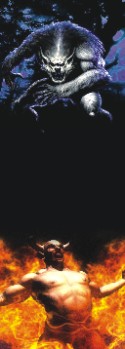

By Raida Kifait Reza
They love tormenting our souls till we can't bear it anymore, they love to see us in deranged insanity and they are there to scare the hell out of us. Yes, they are our favourite paranormal creatures! As they continue to haunt us, let's see what they are actually made of!
Vampires
The first in rank would be these fellahs. Fangs, blood, seduction...bring it on. Regardless of all the stereotypes and clichés, there's really a lot a creator can do with vampires and so many myths that can shape the characters. .. For example, vampires can be evil or they can be good; they can be powerful and sexy and dangerous or they can be completely indifferent. Not to mention all the various powers and politics that can shape the society of a vampire. The best thing about a vampire story is that it can really be a story about humanity and human nature rather than just a cold blooded monster. However, the vampires we are familiar with today, although mutated by fiction and film, are largely based on Eastern European myths. The vampire myths of Europe originated in the Far East, and were transported from places like China, Tibet and India with the trade caravans along the silk route to the Mediterranean. A newly-created vampire is at its most vulnerable; it has little idea of how to survive, and is torn between escape and clinging to the familiar. It may panic; some disintegrate psychologically at this time. Before you start questioning these godforsaken misfits, think again. They will get you.
Ghosts
 They are the departed souls of a mortal flesh tormented by their sins to a point of insanity searching the land for their self believed path to freedom. However, there are so many more categories of ghosts in different cultures that it is confusing to find out what they really are. Hindi Serials and films are likely to die without them. On the other hand, we have ghosts like Shankchunnsi: Female ghost, Nishi: At night calls people out by name from their home, never to be returned again, Aleya: Marsh gas apparitions that confuse fishermen, make them lose their bearings and eventually drown, Skondhokata or Kondhokata: A headless ghost. Many of us probably have seen ghosts and not even realized it. For instance, that pale teenage girl on the bench in the train station or the elderly woman trudging along the side of the road may not be a living being at all. You never know! The next time you are out late at night, the last person you bump into might just have come down for an earthly late night snack.
They are the departed souls of a mortal flesh tormented by their sins to a point of insanity searching the land for their self believed path to freedom. However, there are so many more categories of ghosts in different cultures that it is confusing to find out what they really are. Hindi Serials and films are likely to die without them. On the other hand, we have ghosts like Shankchunnsi: Female ghost, Nishi: At night calls people out by name from their home, never to be returned again, Aleya: Marsh gas apparitions that confuse fishermen, make them lose their bearings and eventually drown, Skondhokata or Kondhokata: A headless ghost. Many of us probably have seen ghosts and not even realized it. For instance, that pale teenage girl on the bench in the train station or the elderly woman trudging along the side of the road may not be a living being at all. You never know! The next time you are out late at night, the last person you bump into might just have come down for an earthly late night snack.
Zombies: These dead guys are pretty popular in the scare zone! They are cultured as mindless, unfeeling monsters with a hunger for human flesh; they are a reanimated human corpse. Zombies look and behave like the conscious beings that we know and love, but "all is dark inside." No emotions, no pain. Yay! You can always outrun a zombie since they're slow. Stories of zombies originated in the Afro-Caribbean spiritual belief system of Vodou, which told of the people being controlled as workers by a powerful sorcerer. Modern zombies, as portrayed in books, films, games, and haunted attractions, are quite different from both voodoo zombies and those of folklore. Modern zombies are typically depicted in popular culture as mindless, unfeeling monsters with a hunger for human flesh, a prototype established in the seminal 1968 film Night of the Living Dead.
Demons: Earliest recorded history makes mention of the existence of demons. Among the tablets of the Avesta, the Holy Book of Zoroastrianism, demons were mentioned by both name and type. Demons have been accused of perpetuating every imaginable crime against humanity including that which is considered most heinous, "possession." From physical assault, to lustful and murderous temptations, to bewilderment and causing nightmares, demons have allegedly assailed mankind from earliest recorded time, which makes them cool in my opinion! The more civilized pagan societies came to consider demons as powerful, supernatural beings who lacked the dignity of gods and who, depending on the circumstance, might be either benevolent or malevolent in their dealings with men. Some demons, like the Greek Pan, were nature spirits; others were guardians of the home or fields or watchers over travelers; still others were spirits of disease and insanity or dream spirits. The list compiled in 1589 by a demonologist named Binsfield was considered to be highly authoritative; in it he listed the following major demons and their particular evils: Lucifer (pride), Mammon (avarice), Asmodeus or Ashmodai (lechery), Satan (anger), Beelzebub (gluttony), Leviathan (envy), and Belphegor (sloth).
Werewolves: Also known as lycanthropes, are mythological or folkloric humans with the ability to shape shift into wolves or wolf-like creatures, either purposely, being bitten by another werewolf or after being placed under a curse. This transformation is often associated with the appearance of the full moon. They garner much less attention than do vampires. Partly this may be because our image of werewolves is that they are bestial and violent, whereas vampires -- while perhaps evil can be suave and sensuous, and cool! Historically, werewolf legends have been used to explain the acts of serial killers. Some suggest that mercury, not silver, might be the best choice for dealing with werewolves. So if you happen to be out on a moonlit night, with no amulet and you hear a howl… you're doomed. Legend has it, that these fellahs come out on Halloween night, so be safe, and watch out…
Sources: http://www.chebucto.ns.ca/~vampire/vhist.html http://www.associatedcontent.com/article/366892/halloween_monster_trivia_13_facts_about.html
http://education.yahoo.com/reference/encyclopedia/entry/demon
http://thepackofar.50megs.com/werewolf.html
Thanks to Shahriar Haque Abir
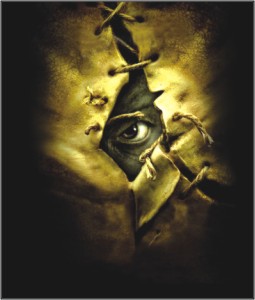

By Faria Sanjana
Fear is undefined, they say! Even if you're certain of what you're afraid of, you can never tell what exactly would send shivers down your spine or give you sleepless nights. What if it was something you never knew existed? Something widely snubbed as unreal? Fear comes in different shapes and sizes. So what shape does it take when it comes in guise of visual media?
Now, it is not a novel debate whether movies of the horror genre are actually worth the watch. Well a lot of people shared mixed views on this topic. Initially, the comments were like “Who cares about horror movies?” When asked further as to why they do not care, answers like “They are not scary anymore” or “We are too old for such films” kept popping up a lot. So there was an extra bit of whining and groaning from my part until I roughly got away with a survey of horror movies.
A video-tape, a phone-call and death in seven days weird combo I must say. I am sure those who watched 'The Ring' would disagree and term it as the deadliest ever. Although the plot may seem quite silly if you narrate it to someone, but people who have actually seen it described the cinematography as “spooky” and “creepy”. “I did not touch video-tapes for a whole month after watching 'The Ring',” commented Asif, university student. In addition to its gothic appearance, 'The Ring' was also applauded for its continuous twists that gripped viewers till the end of the movie.
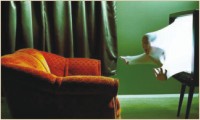 When looking for a movie that held some meaning to it instead of putting scary elements here and there, 'The Sixth Sense' definitely does not need any introduction. Bruce Willis adds to the icing of the cake with his famous “I see dead people” dialogue and his role as Dr. Malcolm Crowe. “Usually scary movies frighten you but this one does more than that and makes you realize that redemption in life is possible,” remarked Rafid, high school student. Other films have graphics that are way beyond their time. 'The Exorcist' is one such horrifying tale of a 12-year old exhibiting supernatural powers and her Exorcist who tries to salvage her possessed soul. It does a good job in intermingling religion with thriller and leaves people with scenes worth remembering.
When looking for a movie that held some meaning to it instead of putting scary elements here and there, 'The Sixth Sense' definitely does not need any introduction. Bruce Willis adds to the icing of the cake with his famous “I see dead people” dialogue and his role as Dr. Malcolm Crowe. “Usually scary movies frighten you but this one does more than that and makes you realize that redemption in life is possible,” remarked Rafid, high school student. Other films have graphics that are way beyond their time. 'The Exorcist' is one such horrifying tale of a 12-year old exhibiting supernatural powers and her Exorcist who tries to salvage her possessed soul. It does a good job in intermingling religion with thriller and leaves people with scenes worth remembering.
Talking about exorcism one cannot get away without mentioning 'The Exorcism of Emily Rose' in which a priest is held on trial for the death of a girl called Emily Rose during the exorcism of evil spirits from her soul. Since it is based on a true story the film leaves the viewers confused on what to believe- fact or the supernatural. Its spine-chilling, horrific moments act as a perfect amalgamation for a horror thriller. Moving away from ghosts and malevolent spirits, I headed to movies consisting of monstrous forms like demons and vampires. 'Jeepers Creepers' is about an ancient winged demon that feasts on human body parts. The film is all about two siblings trying to escape from the demon a.k.a The Creeper. “Although it doesn't send chills down the spine, it can cause sensitive viewers to throw up their dinners!” commented Redwan, high school student.
Your dose of vampires will be fulfilled once you get to see 'Dracula'. The 'Dracula' of 1931 introduced a new species to the frightening creatures' list. Viewers were awed at those blood-thirsty beasts that looked more human-like and debate started whether they actually existed. The new one comprised of great performance from Gary Oldman as Dracula. The frightening creatures' list got bigger and better when 'Frankenstein' released. Adapted from the novel of the same name, this movie brought a full-fledged monster to life on the silver screen that gave the majority gooseflesh.
Scary movies do not necessarily need demons, paranormal incidents and haunted houses. This was proved by the release of 'Jaws'. This movie showed everyone the most heinous side of the creature that we all love to abhor sharks. Most of the people I interviewed acknowledged that prior to 'Jaws', they had no idea how lethal sharks could be. Alfred Hitchcock's 'The Birds' falls in this category of narrating a story unlike any conventional horror films. One must simply watch it and find that birds are not always the perfect pets!
During the survey, it was surprising to find out that whoever answered usually talked about older films (read The Shining, Nightmare on Elm Street, Night of the Living Dead and its sequel Dawn of the Dead). I wondered that how could contemporary movies with better technologies falter with comparison to those. “This is because most of the newer movies do not have any story. Like the sequel of The Ring was a total waste of time,” answered Asif. Others were wary of the fact that most movies were remakes of Japanese or other Asian horror films. “Although I watched 'The Grudge' first, I found the setting of 'Ju-on' creepier,” commented Nayeema, student. Similar views about 'Dark Water' and 'One Missed Call' were heard. Probably 'The Ring' and until very recently 'The Eye' were the ones that had tough competition between its original and the remake versions. These films also had an additional plus point as they heavily relied on hair-raising sound effects and visual screening.
After covering through that immense list, I realized today's kids are drifting into oblivion about horror movies as it ceases to 'scare'. Imagine the thrills that they are missing-staying awake at the dead of night and sneaking with terror under the blanket in cozy armchairs! I sure hope that this does not completely disappear and film-makers come up with more meaningful plots in order to keep the horror movie genre alive.
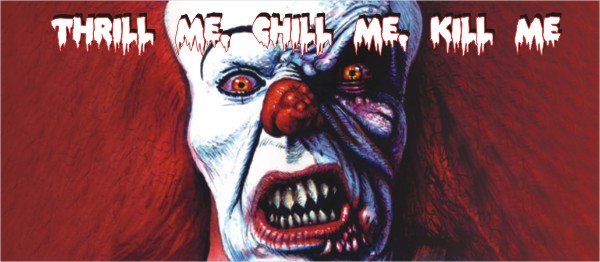
By Sabrina F Ahmad
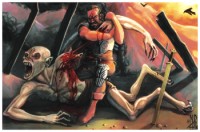 Scary stories have been around since the first time a caveman felt the need to brag about some huge mammoth or saber-tooth or equally dangerous animal that he had to battle against, in the process of describing which, he embellished the narrative with details enough to create a monster out of a mundane animal. This monster would then become the topic of bedtime stories the cave mamas would tell in order to scare their kids to sleep.
Scary stories have been around since the first time a caveman felt the need to brag about some huge mammoth or saber-tooth or equally dangerous animal that he had to battle against, in the process of describing which, he embellished the narrative with details enough to create a monster out of a mundane animal. This monster would then become the topic of bedtime stories the cave mamas would tell in order to scare their kids to sleep.
The horror genre has come quite a distance since then. Our bogeymen have morphed through the ages, even as the quality of fear changed. Let's take a look at some of the ways in which the horror genre has evolved, why don't we?
Monster Bash
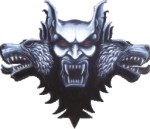 Monsters have featured largely in the horror genre since the beginning. Consider Beowulf, one of the oldest stories written in the English language. It was the tale of a single hero who defeated the fearsome monster Grendel. From the very beginning, Man was afraid of anything that threatened his existence. Even before writing was invented, the old ballads and poems featured ogres, dragons, and brave heroes who defeated them. Many of the earlier horror stories sprung from a lack of knowledge about the enemies that the hero presented; be it a strange ailment that kills people, or a large creature, what made it frightening was the fact that the protagonist was ill-equipped to deal with the adversary, and had to rely on sheer courage and dumb luck. As we began to learn more about our environment, that dragon became just another big lizard, and these themes branched off into the action/adventure genre.
Monsters have featured largely in the horror genre since the beginning. Consider Beowulf, one of the oldest stories written in the English language. It was the tale of a single hero who defeated the fearsome monster Grendel. From the very beginning, Man was afraid of anything that threatened his existence. Even before writing was invented, the old ballads and poems featured ogres, dragons, and brave heroes who defeated them. Many of the earlier horror stories sprung from a lack of knowledge about the enemies that the hero presented; be it a strange ailment that kills people, or a large creature, what made it frightening was the fact that the protagonist was ill-equipped to deal with the adversary, and had to rely on sheer courage and dumb luck. As we began to learn more about our environment, that dragon became just another big lizard, and these themes branched off into the action/adventure genre.
Angels and demons
In 1235, the Vatican, authorized the commencement of an Inquisition to re-establish the orthodoxy of the faith. The charge of heresy soon became entangled with the charge of witchcraft, and in this form took until the seventeenth century to die away. The prevailing fear was the fear of the suffering that comes as a consequence of evil. From Dante's La Comedia to Milton's Paradise Lost, there were vivid images of hellfire and brimstone, and history provided flesh-and-blood monsters in the form of Vlad the Impaler, also known as Dracula, who would become an important literary figure in the years to come. The Inquisition also created a craze about witches, which was reflected in plays as late as Shakespeare's Macbeth. The spirit of the Inquisition sparked off the Gothic movement, with Horace Walpole's The Castle of Otranto considered to be the first Gothic novel. As described by Kyla Ward “The Gothic is a literature of decay. This is a moral judgment; for after all, the matter of the Gothic tale is a great structure succumbing, crumbling, sinking into all perversions of the architectural, human, vegetable and animal'.
Tell me your thoughts
Between the 19th to the early 20th century, the horror authors Bram Stoker or Mary Shelley relied on an understanding of human nature and psychology to instill fear. As people became more familiar with the threats of the animal world around them, their monsters took on a shape closer to home. Dracula wasn't scary because of his big fangs; he was scary because it was so easy for you to become like him. The fear came from the possibility of you becoming the monster, a theme that appears again and again in modern-day RL Stine's 'Goosebumps' series. As the blogger 'Malo' from the 'Voodoo Who do' blog explains, “The bite merely acts as the catalyst, the metaphorical key to the lock that people in Victorian society placed upon their darker urges. In fact, classic horror literature relied heavily on the use of fear and anxiety about the darker sides of humanity to scare their audiences.”
What you don't know can scare you
Sometimes, what you know you are capable of can frighten you, as was seen in the earlier horror stories featuring werewolves, vampires and zombies. Just as easily, we are scared of things that we don't understand.
Later horror masters like Edgar Allen Poe and HP Lovecraft played with this idea in their stories. Lovecraft's focus was on showing the futility of human endeavour against unbeatable forces, as seen in his Cthulhu stories. The fear came from knowing exactly that you were powerless, the price you pay for meddling with things that you are not supposed to know.
Poe, on the other hand, relied heavily on the consequences of falling victim to things outside one's control, which he expertly combined with the very real threat of death, as seen in The Masque of Red Death.
Truth is scarier than fiction?
Some authors didn't even need to use supernatural elements in their art; real life was scary enough. Franz Kafka, in his unfinished novel The Trial captured the essence of waking nightmare in an ever-shifting dream-scape of bureaucracy gone mad, a theme that would influence, if indirectly, much of modern horror fiction.
In the wake of World War II came the rise of the dystopian novel. Worried about the direction the world politics was taking, several authors took that as a theme for creating fear. One of the most successful portraits of a futuristic totalitarian regime is presented in George Orwell's Nineteen Eighty-Four. The other main contender in this field of political nightmares is Aldous Huxley's Brave New World. After the bombs went off in Japan, another element was added to this new form: the twin threats of nuclear wars and environmental hazards, which led to the development of post-apocalyptic fiction. John Wyndham, with his Day of the Triffids best exemplifies this genre.
Present day perils
Horror today draws from a vast cornucopia of inspiration. You have your monsters and beasties (Vampire Chronicles), your post-disaster scenarios (The Road), your psycho-next door (Hannibal). We're living in the age of paranoia where everything, from a video cassette (The Ring) to your pet dog (Cujo) is a potential threat.
The modern day chiller ranges from the psychological, to the supernatural, to the plain bizarre. While Hollywood is going nuts using gore and special effects to try and scare an increasingly desensitized audience, the literary field retains subtle and effective tools to ensure that you get goose-bumps while you turn the pages. Be afraid. Be very afraid.
Sources: Wikipedia, the Voodoo Who Do Blog, and The Horror Timeline by David Carroll and Kyla Ward
